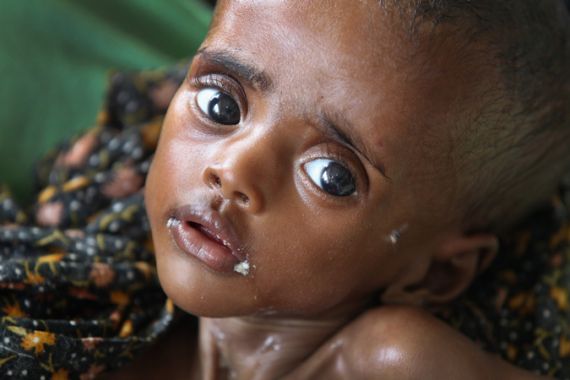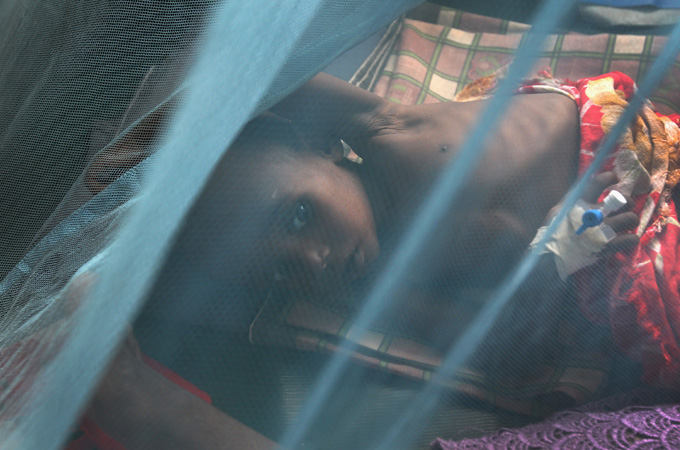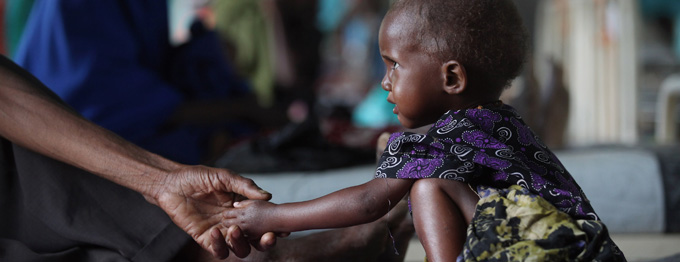Southern Africa: Breaking the negative cycle
Southern Africa has been bombarded by many stressors, leading to a food crisis and lack of hope for children’s futures.

 |
| ‘Multiple stressors’ are at the root of regional food insecurity – compounded by the AIDS epidemic [GALLO/GETTY] |
A chronic food security crisis has unfolded across Southern African since early 2000, with many more people than during the 1990s now living “close to the edge” and increasingly unable to absorb shocks or stresses.
Several countries in Southern Africa now see large numbers of their population, many dependent on rain-fed farming, barely subsisting at poverty levels in years without shocks, and highly vulnerable to the vagaries of the weather, the economy and government policy. Arguably, something dramatic has changed in the region, and most assessments understand this to be as much a crisis of livelihoods or of development in general, as a series of simple food shocks.
Understanding the underlying causes of this crisis inevitably means untangling the knot of “multiple stressors”, which lie at the root of regional food insecurity, compounded in particular by the AIDS epidemic. Multiple stressors can include any changes that manifest as shocks (floods, job losses, death) or gradual changes (land degradation, deterioration of health care systems).
Food security, defined here as the success of local livelihood strategies to guarantee access to sufficient food at the household or family level, is only one dimension of a wider livelihood crisis. The United Nations (UN), charged with overseeing the unprecedented food aid response in Southern Africa between 2001 and 2006, defined the prevailing situation as the “Triple Threat”: The combination of HIV and AIDS, food insecurity and a weakened capacity for governments to deliver basic social services has led to the region experiencing an acute phase of a long-term emergency.
HIV/AIDS exacerbates the impacts of other stressors and intensifies the insecurity of many communities affected by the disease in Southern Africa. The epidemic contributes to the crisis by reducing production and income, as labour and capital are lost to disease and death; undercutting the ability of households to cope with shocks; and contributing to losses of scarce, skilled staff in the public service and private enterprise.
Another possible consequence of the AIDS epidemic is increasing inequality, even where average incomes remain constant, through the “impoverishing” nature of the disease affecting some families and not others.
When a social unit such as a household is affected by a shock or a stress – for instance a sudden flood that washes away irrigated fields – temporary adjustments, known as “coping strategies” become necessary for survival. Research has reiterated the factors that determine a household’s resilience or ability to cope; these include access to resources, household size and composition, access to resources of extended families and the ability of the community to provide support.
If this resilience is diminished, any external “shock”, whether it is due to climatic factors, civil disturbance or economic mismanagement, becomes increasingly difficult to absorb. In other words, households are finding it more difficult to “cope”. Using this concept we explore two key potentially harmful implications for households’, and in particular children’s, future security: (1) adoption of “erosive” coping strategies to deal with current needs and (2) inability to act or plan for the future.
Erosive coping strategies and inability to plan for the future
Recent empirical studies conducted in Southern Africa have shown evidence of strategies that risk increasing future vulnerability of children. For example, research reflected in a comparative qualitative study conducted on a rural site in Chikwawa District, Malawi, and a peri-urban site in Amajuba District, South Africa, revealed that households reduced food intake and dietary diversity to deal with a lack of food and other stressors, with obvious implications for family members’ health, children’s school attendance and adults’ income-earning ability in the long run.
Amongst Malawian households interviewed, selling or slaughtering livestock threatened future food security through diminished ability to “provide for the household”. Moreover, Chikwawa family members’ engagement in a greater amount of casual work for third parties occurred at the expense of reduced investment in their own land, thus potentially affecting productivity in the long run.
Children in this context were a critical source of labour for households’ own lands but at the cost of affecting their education at school, thus prefiguring future wage income insecurity or future inability to “engage in modern agriculture practices which require reading and understanding of concepts and instructions”.
Likewise, marrying off daughters at a younger age represented a coping mechanism that, like child labour, reflected a system under severe strain: Young girls were being pulled out of school and made dependent at a very early age, at the possible cost of growing up to be unskilled and uneducated.
Inability to plan for the future
 |
| Studies show that parents dealing with stressors such as AIDS are unable to plan for their children’s futures[GALLO/GETTY] |
A consequence of families’ inability to recover sufficiently from the various entwined stressors is that they are unable to move beyond immediate needs to adequately plan or act for the future. Too often short-term demands around basic survival limit choices that might secure the longer-term livelihoods of children. Moreover, families affected by these stressors often lack material resources, receive limited external support and have poor access to appropriate services.
A common finding was, for example, the scarcity of long-term parental planning, despite caregivers’ strong concerns for the future of their children and awareness of threats to their welfare, options and potential strategies.
The common refrain of these “parents” was that they lacked resources and opportunities to make and implement substantive plans to safeguard their family’s future. Notably, they regarded saving for or investing in children’s education (including tertiary education) highly, as education was seen as the key to formal employment and a “better future”. However, they were resigned to the fact that they could not carry this out unless their financial situation were to change. This finding was echoed in a study conducted with mothers or female caregivers across three provinces in South Africa.
Despite expressed anxiety about their children’s future, various studies have shown that very few parents living with HIV make plans or provisions for their children’s future. While decisions around living arrangements are often related to socio-cultural factors, as well as civil, religious and customary law, financial vulnerability and weakening extended family networks are significant constraints to succession planning, especially in the context of a generalised HIV/AIDS epidemic.
Conclusions
This suggests that there is cause for concern about the future wellbeing of children in Southern Africa. Families are often unable to recover sufficiently from the many “entwined” stressors they are exposed to, representing their “external” vulnerability, with the result that they are struggling to adequately plan and act to provide their children with the means to achieve a stable existence.
This phenomenon, together with recourse to short-term strategies that could further erode future resilience, suggests that families may become ensnared in a vicious downward spiral, as their “internal” vulnerability gradually increases.
The challenge, as far as responses are concerned, is that by pulling at one strand of the knot of stressors, one only entangles this situation further. Understanding and responding to the widespread livelihoods crisis requires looking at the complexity of these multiple stressors, to try to comprehend their interconnections and causal links.
Yet for more than a decade, many efforts are proving to be stopgap measures in the face of societal and environmental change, including HIV and AIDS. It can be argued that there is a misfit between the problem and the institutional response, as responses from national and international players have remained relatively static.
A clear argument has emerged for more comprehensive interventions that are sustainable and enabling for families to underpin livelihoods and children’s security. This becomes particularly important when looking at the extended time scale of the AIDS epidemic in Southern Africa.
By increasing the resilience and range of options that families have, through services and safety nets, one can optimise the positive outcomes for children. Policies need to focus more on promoting children’s physical and psychological wellbeing, and the capacity and stability of their families. They need to address both their external vulnerability, by alleviating stressors threatening households, as well as their internal vulnerability, by strengthening their resilience or ability to cope.
Decisive, well-informed and holistic interventions should aim to break the potential negative cycle that threatens the stable future wellbeing of Southern Africa’s children.
Scott Drimie leads a research and facilitation consultancy with regional associates focusing on food security, food systems and livelihood issues in southern Africa. He is an Associate Professor in the Department of Interdisciplinary Health Sciences at Stellenbosch University where he chairs the Advisory Board of the University’s Food Security Initiative. He is a Visiting Research Associate at the African Centre for Migration and Society.
Marisa Casale joined the Health Economics and AIDS Research Division (HEARD) of the University of KwaZulu-Natal as a Researcher in 2005. She has a Masters in Rural Development Studies, from the University of Padua, Italy, and is currently a doctoral candidate with the Department of Psychology at the University of Cape Town.
The research discussed was undertaken as part of the RENEWAL programme of the International Food Policy Research Institute, some of which is published here.